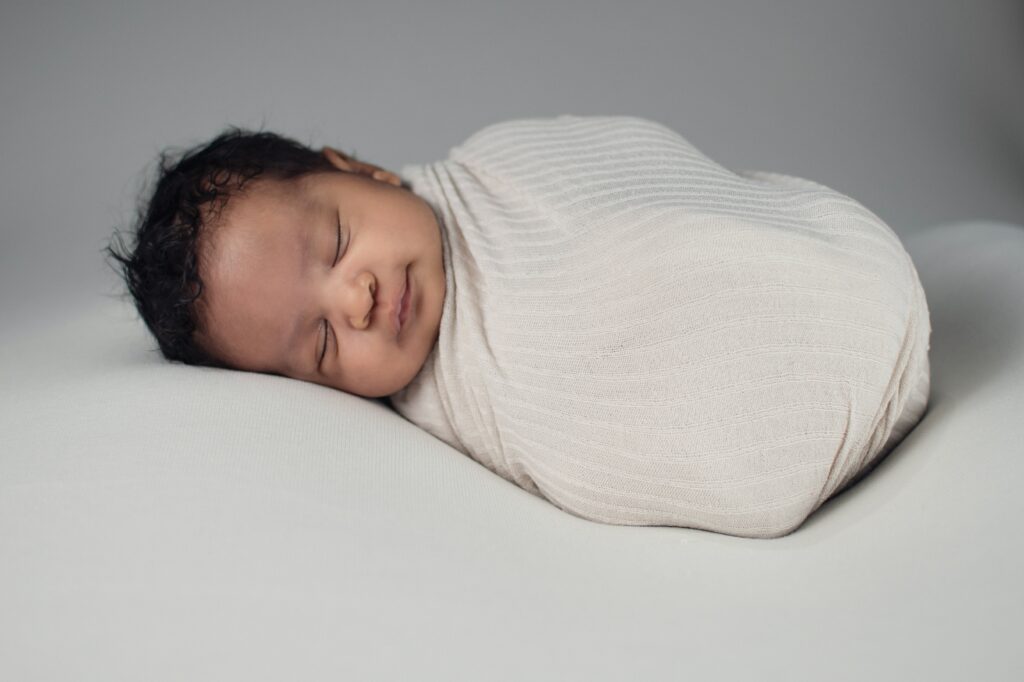
BLOG
When I first became a mom in 2014, I knew very little about infant sleep. The first of my friends, and the first in our family to have babies, the terms ‘wake window’ ‘drowsy but awake’ and ‘self soothe’ were entirely foreign to me. Literally the only thing I knew was what I saw in the hospital – if you want your baby to sleep, you had to fold a blanket into a magical cocoon that calmed them long enough to put on a fresh adult diaper or take a shower.
Now, 3 kids and 9 years later, I know that ‘drowsy but awake’ and expecting a baby to ‘self soothe’ are myths. What I never learned as a mom, and only truly understood through extensive study and research to become a certified family sleep and well-being coach, is that the magical swaddle is actually no longer recommended, and is potentially harmful to our babies.
Babies are born with 6 primitive reflexes that are meant to be integrated and ‘lost’ as the baby grows and develops. After rooting and sucking, the most commonly recognized primitive reflex is the moro reflex, which is also known as the startle reflex. If startled by a loud sound or movement, a baby will throw back the head, extend out the arms and legs, then pull the arms and legs back in. When it comes to swaddling, there are two main reasons that it has commonly been recommended, and the first is to help combat this startle reflex by restraining the baby’s arms and legs.
The issue with swaddling to discourage the moro reflex is that, in order for babies to integrate their primitive reflexes, they need the opportunity to overcome them, and swaddling discourages this. There are some studies that suggest if a baby’s primitive reflexes are retained (i.e. if babies don’t have an opportunity to work through the reflexes and integrate them naturally), that it can contribute to a child becoming hypersensitive to different types of sensory input including temperature, touch, movement, visual and/or sound1. This is a really contentious point, but the more relevant point, as it relates to sleep, is that the swaddle has to come off at some point, and the sooner you remove it (or, ideally, not use it at all), the better. Once a baby is able to roll, swaddling becomes entirely unsafe, and needs to be stopped immediately.
The AAP itself doesn’t have a clear stance on an exact timeline as to when to stop swaddling, other than to say that it is unsafe to swaddle once a baby begins to roll. This can range from one baby to the next, anywhere from 2 to 6 months of age. So, it is generally recommended that if you do choose to swaddle, that you transition away from it by 8 weeks of age.
Additionally, swaddling puts a baby into a deeper state of sleep (which is why most traditional sleep consultants praise its use), but research shows that the deeper the state of sleep, the higher the risk for SIDS. The moro reflex is actually a natural, built in protective mechanism. Aside from the obvious initial purpose, which was to startle a baby if there was an external danger (baby wakes at the sound of the lurking sabre tooth tiger, which wakes mom, and mom scares off said tiger), its purpose is to startle baby awake if baby’s breathing slows down too much. Remove the ability to startle, and this extra layer of internal protection is now gone. One of the primary causes of SIDS is apneas – sudden periods of stoppage in breathing – while baby is sleeping.
Rachel Y. Moon, M.D., FAAP, lead author of the AAP safe sleep guidelines and chair of the Task Force on SIDS has said, “Parents should know that there are some risks to swaddling. Swaddling may decrease a baby’s arousal, so that it’s harder for them to wake up. That is why swaddling can seem so attractive to new, sleep-deprived parents—the baby sleeps longer and doesn’t wake up as easily. But we know that decreased arousal can be a problem and may be one of the main reasons that babies die of SIDS.2“
The second reason swaddling is often seen as the holy grail of infant sleep is because it gives the baby the feeling of a tight hold, which is supposed to mimic the feeling of being in the womb. If you’re reading this, you’re likely already a parent yourself and know first hand that the fourth trimester is real – babies crave constant contact from their primary caregiver and swaddling can give mom and dad a little break. As a mom of little kids myself, I totally get the attraction of using the swaddle for longer stretches of sleep.
The trouble is – and here is where the new recommendations against swaddling come into play – that if used incorrectly, a swaddle blanket can cause a suffocation risk to a baby. Additionally, swaddling can create elevated risks of hip dysplasia3, as well as elevated risks of hyperthermia (overheating) with incorrect use4. The National Resource Center for Health and Safety in Child Care and Early Education updated their guidelines in 2011 to advise against swaddling in child care settings, and Minnesota, Texas, and Pennsylvania have all banned swaddling in childcare centers as a result.
In Canada (where I am based), there has been a movement to discourage parents from swaddling outside the hospital setting. In 2014, the Registered Nurses Association of Ontario updated guidelines to say, “There is currently no evidence on the ‘safe way’ to swaddle an infant, and hence caution regarding swaddling should be expressed with parents/caregivers.5“
In British Columbia, Canada, the recommendation is to swaddle from the chest down with hands exposed while awake, and not to swaddle at all while baby is asleep. HealthLinkBC even goes as far as to say, “Swaddling is not needed, and it can be risky. It is safest for your baby not to be swaddled.6“
And finally, if you are a breastfeeding parent, swaddling can interfere with the breastfeeding relationship. When babies sleep deeper and longer, they are less likely to rouse for feeds. If a swaddled baby sleeps an hour or more longer than they would if unswaddled, it can result in missed feeds at night. These missed feeds can hinder milk supply and slow down a baby’s weight gain. Further, when a baby does wake, they need their arms and hands to explore in order to find the breast, and restricting hand movement by swaddling can make latching, and breastfeeding in general, much more difficult.
So if I’ve now convinced you as to why I don’t recommend swaddling to my clients, you’re probably thinking, what am I going to do instead? Here are a few tips to help get through the newborn stage without swaddling:
If you are struggling with sleep, I am always here to help! Click here to book your free discovery call. I’m a family sleep coach dedicated to helping clients from infancy through adulthood to go from tired and stressed to rested and confident without any sleep training or CBT methods. If you need a better night’s sleep, please reach out!
Sources:
